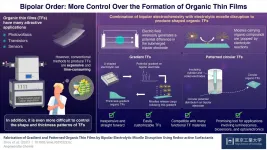A recent review of nearly 7,000 studies of meditation practices found that less than 1% of them measured adverse effects. Willoughby Britton, an associate professor of psychiatry and human behavior at Brown University, said that this is largely because assessing adverse effects (a process known as "harms monitoring") in non-pharmacological treatments like mindfulness-based meditation programs is difficult to do well.
To address that gap, Britton conducted a new study on adverse effects in mindfulness-based programs that identified common obstacles to harms monitoring and, importantly, showed how to address them. The study also found that the rates of adverse effects from mindfulness were similar to those found in other psychological treatments.
The study was published on May 18 in Clinical Psychological Science.
"Our ultimate goal is to maximize the efficacy of mindfulness-based meditation while minimizing harms," said Britton, who directs the Clinical and Affective Neuroscience Laboratory at Brown. "In order to address risks and modify treatment accordingly, you need thorough and detailed knowledge about potential harms. Our study, the most comprehensive of its kind, provides a blueprint for how to accurately assess the risks of mindfulness-based meditation programs."
~Why no one wants to talk about meditation's adverse effects~
The adverse effects of mindfulness-based meditation programs are often an unpleasant topic for providers and participants alike, Britton said. For the study, she and her colleagues reviewed the most current harms monitoring best practices from regulatory agencies like the World Health Organization, the National Institutes of Health and the U.S. Food and Drug Administration. In the paper, they outlined the key considerations around assessing adverse effects, including hesitancy of participants to report negative reactions to treatment because of feelings of shame or a desire to please the researcher or instructor.
Researchers and mindfulness teachers (Britton is both) are understandably more focused on the help they can provide than any harm they could cause. As a result, a lack of negative feedback from participants is often interpreted as evidence of absence of harm. "It's very easy for our enthusiasm and desire to help to become a kind of blindness," Britton explained.
Another complicating factor, she said, is the lack of knowledge of proper harms assessment.
"Often the mindfulness teacher will ask the class, 'Did anyone have any challenges with your meditation practice this week?'" Britton said. "But participants, in general, tend to avoid answering open-ended questions asked by the teacher in a public setting. Research has shown that having someone other than the teacher ask specific questions in a private setting will increase the likelihood of honest reporting."
Finally, she highlighted the fact that term "adverse" is a highly subjective judgment that can vary across people and even across the same person in different contexts.
"The re-living of a previous trauma may be healing for some and destabilizing for others, in the same way that the drowsiness caused by cold medicine -- or meditation -- may be undesirable or 'adverse' in the morning but highly desirable before bed," she said. What's more, Britton added, the literature shows that mental health treatment providers (like therapists or doctors) may dismiss patient complaints or reframe them as a sign that the therapy is working.
~Designing a model assessment~
Britton's research team followed 24 current harms monitoring guidelines to assess the nature and frequency of meditation-related adverse effects in mindfulness-based programs. The study participants were representative of typical meditators in the U.S.: predominantly middle-age women seeking methods to self-manage mild to severe levels of anxiety, depression and stress. After completing one of three versions of an eight-week mindfulness meditation program, participants were interviewed by a researcher unaffiliated with the treatment about their experiences, with 44 questions based on previous research of meditation-related challenges.
To more accurately and thoroughly capture patient perspectives, this study allowed each participant to evaluate the emotional tone or "valence" of each of 44 meditation-related experiences as well as the impact it had on their life and functioning. By asking participants specific questions about duration and impact, researchers were able to differentiate temporary distress, negative-impact side effects and "lasting bad effects." In this way, the researchers sought to clarify which effects were experienced as "adverse" on a case-by-case basis.
To accommodate the varying definitions of harm, results were reported in tiers of severity ranging from "transient distress during meditation" (i.e., temporary) to "enduring impairment in functioning" -- or "lasting bad effects."
~The "what" is as important as the "how"~
The significance of the study, Britton said, has as much to do with what it found as how it found it.
"The fact that meditation can cause altered states, for example, isn't news: It's something that people have been talking about for centuries," Britton said. "What we haven't been very good about is measuring the impact and significance of these states on individual participants."
Of the 96 participants, 58% reported at least one meditation-related adverse effect, which ranged from perpetual hypersensitivity to nightmares to traumatic re-experiencing. Meditation-related adverse effects with negative impacts on functioning occurred in 37% of the sample. Six percent of the sample had "lasting bad effects," or impairments in functioning lasting more than one month. Notably, the researchers say, this rate is similar to those of other psychological treatments.
In the study, meditation-related effects with negative impacts tended to be associated with signs of what's called dysregulated arousal -- for example, the participants reported feeling anxious, hyper-stimulated or emotionally flat or disconnected after meditating.
This is important for instructors and participants to note, Britton said, because unlike the experiences of anxiety or insomnia, a feeling of being dissociated or emotionally checked-out is not always experienced as unpleasant and can provide some relief, especially for a person suffering from intense anxiety. Yet in the study, this feeling of dissociation tended to predict more significant and lasting impairment in functioning.
"This is where the differentiation between valence and impact becomes important, because the valence, or emotional tone, of an experience might be not particularly distressing at the time," Britton said. "Meditators are often taught to reappraise their experience as not being problematic, and to accept it for what it is. Our results are basically saying that when it comes to dissociation, this approach isn't going to work."
Britton and colleagues also found that the open-ended question "Have you had any unexpected, unpleasant, adverse or challenging experiences as a result of mindfulness meditation practice during or following the program?" underestimated the true rate by 70%, confirming the inadequacy of open-ended questions compared to specific ones.
The study concludes that the active ingredient of these therapeutic programs, which is mindfulness meditation practice, can be associated with both transient distress and enduring negative impacts on life and functioning. Britton said that it is important to note that adverse effects and benefits are not mutually exclusive: many of the same participants who reported adverse effects also reported improvements in depression.
Britton noted that the intent of the study, as well as of her broader research, is not to discourage mindfulness-based meditation programs -- rather, it is to generate findings on both the positive and negative effects so that providers and meditators can make informed decisions.
She compared mindfulness to aspirin, as an example. This medicine-cabinet staple can cause nausea, heartburn and stomach cramps -- and taking a daily aspirin can cause gastrointestinal bleeding in some people. But these potential adverse effects do not take away from aspirin's many benefits. Instead, detailed knowledge about the benefits and risks allows practitioners to make educated, effective and safe recommendations to specific patients.
"That's where we need to get with mindfulness, too," Britton said. "Our study is an attempt to bring harms monitoring up to the standards of other treatments so that providers can identify events that require monitoring and intervention in order to maximize the safety and efficacy of mindfulness-based meditation."
INFORMATION:
Brown-affiliated co-authors on this study include Jared R. Lindahl, David J. Cooper, Nicholas K. Canby and Roman Palitsky. The study was funded by the National Center for Complementary and Integrative Health at the National Institutes of Health.




